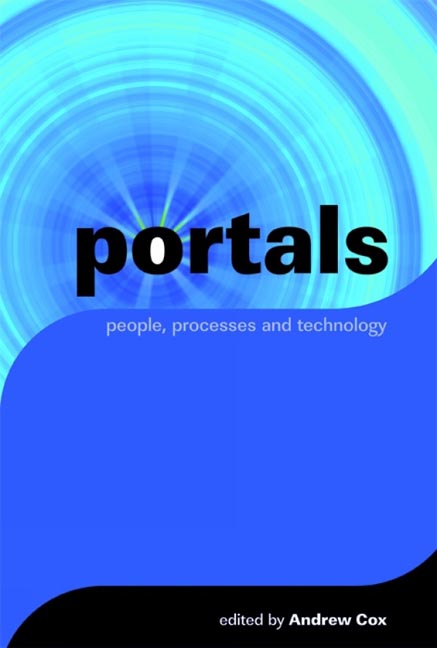Book contents
- Frontmatter
- Contents
- Introductory preface
- Section 1 Core themes
- Section 2 The library and the portal
- Section 3 The portal in the corporate sector
- Section 4 Portals in the public sector
- 12 Community portals and the e-Confluence Zone: where bottom-up meets top-down
- 13 Portal implementation in UK higher education institutions: a comparative analysis
- 14 MyUU: a case study of the Utrecht University portal
- Section 5 The future
- The contributors
- Index
12 - Community portals and the e-Confluence Zone: where bottom-up meets top-down
from Section 4 - Portals in the public sector
Published online by Cambridge University Press: 09 June 2018
- Frontmatter
- Contents
- Introductory preface
- Section 1 Core themes
- Section 2 The library and the portal
- Section 3 The portal in the corporate sector
- Section 4 Portals in the public sector
- 12 Community portals and the e-Confluence Zone: where bottom-up meets top-down
- 13 Portal implementation in UK higher education institutions: a comparative analysis
- 14 MyUU: a case study of the Utrecht University portal
- Section 5 The future
- The contributors
- Index
Summary
Introduction
Community portals use technology as a presentation medium for community and civic networking. Although the intrinsic properties and functionality of such portals are similar, the generic term ‘community portal’ as it has evolved over the past decade encompasses two quite distinct types of activity:
• civic portal – government sponsored and working top-down
• civil portal – organized by activists and working bottom-up.
Community portals have to be considered in the wide perspective of the sociotechnological context of citizen–portal relationships. Community portal development has technical, organizational and human aspects: engaging social science, information systems and telematic technology. In the government domain of civic portals the shift towards digital government (e-government) places the portal as a significant ‘presentation’ gateway component within a wider set of potentially transformative changes, delivering new interactive services for citizens.
During 2000–5 a shift took place in which the topic of community portals migrated from the domain of telematics to the new field of community informatics (Gurstein, 2004), representing the concept as a broader socio-technological endeavour. This links to the newly recognized civil society constituency, given prominence by the processes around the World Summit on the Information Society (WSIS).
Community portals
Schuler (2005) finds that ‘technology on its own is not a panacea for citizen access to government services and citizen–citizen interactions’, and Mumford (2003) explains that ‘technology is only one piece of a very complex puzzle’; technology is not the only driver. The need to understand portal requirements from a citizen user perspective is essential. The ‘people’ element, especially the creation of local champions, is a critically important factor in the development, implementation and sustainability of community networks (Gurstein, 2004; Mumford, 2003), and should therefore be a prime driver of community portal development. But, if it is clear that analysis of community portals cannot be based solely on technological determinism, until recently there has been a relative lack of academic research that straddles the domains of telematics and social systems (Bannon and Griffin, 2001; Romm and Taylor, 2000). In particular, there has been a paucity of evaluation of the technical architecture of community portals. According to Bannon and Griffin (2001, 40), commenting on community network projects, ‘while there is a wealth of anecdotal material as to the successes and failures of such experiments, there is, unfortunately, a lack of objective evaluation studies’.
- Type
- Chapter
- Information
- Portalspeople, processes and technology, pp. 149 - 166Publisher: FacetPrint publication year: 2006



